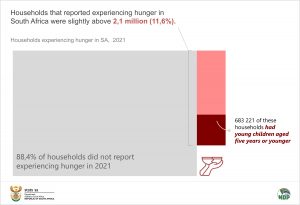Focus on food inadequacy and hunger in South Africa in 2021
In 2021, about 2,1 million (11,6%) of South African households reported experiencing hunger.
South Africa faces challenges ranging from high unemployment and poverty to the ongoing energy crisis and rising costs of living. These impact negatively on South Africa’s state of food security by making food expensive and inaccessible to many and increasing the number of people and households experiencing food inadequacy and hunger.
Using data obtained from the General Household Survey (GHS), Statistics South Africa has published a report that assesses the country’s state of food inadequacy and hunger in 2021.
The World Food Programme (WFP) defines people as being food secure when “they have availability and adequate access at all times to sufficient, safe, nutritious food to maintain a healthy and active life”.
Results indicate that out of almost 17,9 million households in SA in 2021, almost 80 percent (14,2 million) reported that they had adequate access to food, while 15 percent (2,6 million) and 6 percent (1,1 million) stated that they have inadequate and severe inadequate access to food, respectively.
In 2021, two-thirds of these households were in urban areas, and almost half a million of them were found in the country’s largest cities; Cape Town (240 970) and Johannesburg (238 610).
More than half a million (683 221) households with children aged five years or younger reported experiencing hunger in 2021. Children who do not have adequate nutritious food cannot develop as they should and are at a high risk of acute malnutrition. This can lead to stunting, which affects both physical and cognitive development in malnourished children. Of those households with children aged five or younger, 20,1 percent were in KwaZulu-Natal (non-metro areas) followed by 13,6 percent in Johannesburg, and 12,4 percent in Cape Town. Children who suffer from malnutrition and hunger struggle to concentrate and learn, placing them in an extremely vulnerable position and ultimately perpetuating the cycle of poverty and ill-health.
In 2021, 3,1 million (17,3%) households were involved in agricultural activities. The overall proportion of households who were engaged in the agricultural production of food is still fairly low in the country, and are mainly located in non-metro and rural areas. About 12 percent of households that reported being involved in agricultural activities said that they were doing it as a main source of food for the household, while 74,5% stated that it provides an extra source of food for the household. One in five female-headed households engaged in agricultural activities in 2021. This proportion is slightly higher than households headed by males (15%) engaged in agricultural activities to produce food.
Employment plays a critical role in ensuring a household’s food security; nearly 19,0 percent of households without an employed member experienced hunger compared to 7,9 percent of those that had at least one employed member.
Urban areas, particularly the biggest metros, (i.e. the City of Johannesburg and the City of Cape Town) are associated with high proportions of households that reported inadequate and severe inadequate access to food. These two metros are among the fastest growing cities in South Africa according to projections by the United Nations (UN) and other organisations, partly because they are the receiving large volumes of people seeking employment and better living conditions. Thus, more urban households should be encouraged to participate in agricultural activities or in the production of their own food as part of strategies to increase household food security.
According to the Food and Agriculture Organization (FAO) world hunger has increased by 150 million since 2019 (pre-COVID-19 pandemic) to 828 million people in 2021. Asia (425 million) and Africa (278 million) were the worst affected continents in 2022. There were some expectations that world hunger could improve post the COVID-19 pandemic; however, world hunger increased, casting doubts on whether the world could reach its global target of Zero Hunger by 2030.
For more information on food inadequacy and hunger in South Africa, download the full report here.



